Ikat silk sarees from Orissa (also known as Odisha) are amongst the most exquisite Indian textiles. Orissa is famous for its spectacular weaving and textile art, and Ikat silk sarees are the finest examples of the same.
These Orissa sarees have a special place in Indian history, and their exclusivity can be attributed to the impeccable skill of the artisans who practise this weft and warp dyeing technique to broach the gorgeous appeal of Ikat sarees. This unique form of design has also been termed ‘poetry on the loom.’
Odisha Ikkat was given the GI tag in the year 2007 by the Controller General of Patents Designs and Trademarks under the GI Act of 1999, Government of India.
In this blog let us learn about, what is Ikat, the Ikkat saree origin, how pure Ikkat silk sarees are made and some of the famous Ikkat patterns.
History Of Ikkat Silk Sarees Origin
Ikkat saree origin in Orissa is connected to an age-old tradition of the region known as the Lord Jagannath cult. The four primary colours which were used in Ikkat patterns are namely; white, black, yellow, and red. These four colours have a connection with the Vedas, although the green colour was added to the designs subsequently.
Even in ancient times, ikkat on silk were ritually significant where shlokas or stanzas from Gita Govinda - a 12th century devotional poem by Jayadeva - were printed along with motifs like sun, elephant and more.
The temple architecture from ancient times has deeply inspired Ikkat design patterns in Orissa. Ikkat silk saree origin is ancient however, it is still widely used today. Variations of pure Ikkat silk saree patterns may be found in various parts of India, including Odisha, Gujarat, Telangana and Karnataka.
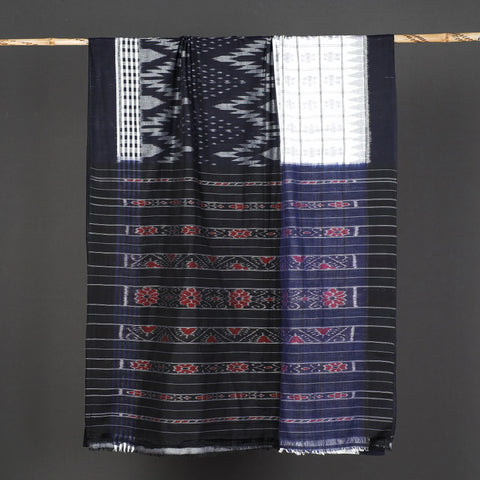
How Ikkat Silk Sarees Became a Symbol of Heritage
Odisha’s Ikkat tradition has evolved into a symbol of elegance and tradition. The ancient tie-and-dye technique or handwoven Ikkat silk sarees involves meticulously dyeing the threads before weaving, resulting in intricate and mesmerizing patterns.
The bold motifs and rich hues of pure Ikkat silk sarees is a labour of love by skilled artisans. Their craft have been passed down for generations.
According to handloom Ikkat history, pure Ikkat silk sarees hold cultural significance in the regions of Odisha, Telangana and more. Ikkat sarees are worn during festivals and occasions.
Even today Kkandua Ikat - silk saree with Gita Gobinda ikat resist is used as an offering to Lord Jagannath in Puri. Many devotees adorn their home mandirs with Kandua Ikkat.
The technique of Ikkat is called ‘bandha’- (tying). Some of the names of prominent motifs used handloom Ikkat history are surya bandha (sun), gaja bandha (elephant).
Oriya brides are often spotted in pure Ikkat silk sarees on their wedding day, keeping their tradition alive. Sambalpuri Ikkat sarees are a symbol of cultural heritage among the community.
Odisha’s Ikkat tradition has been a symbol of its heritage and refined taste. The rich colours and intricate motifs have made it popular among Indians world wide with women buying Ikkat silk sarees online from different corners of the world.
Types Of Ikat Patterns
Ikat is the use of a special dyeing technique to create distinct designs on the fabric online. There are mainly three types of Ikat patterns of Ikkat weaving:
-
Warp Ikat
In Warp Ikat, the fibres of the weft yarn are dyed in a solid colour and the warp yarn is resist-dyed. In this form of Ikat, the design is evidently visible when wound on the loom.
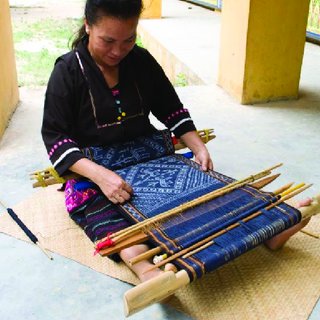
-
Weft Ikat
In Weft Ikat, the weft yarns are rest dyed and the design pattern is visible only when the weaving is in progress. This requires a lot of precision and skill on part of the artisan.
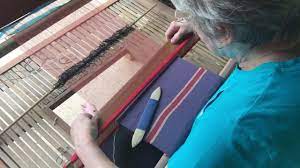
(image credit:- youtube)
-
Double Ikat
This is the most complicated form Odisha’s Ikkat tradition pattern where both warp and weft yarn are supposed to be resist dyed. This is an extremely time-consuming process and hence sarees with this Ikat design pattern are quite expensive.
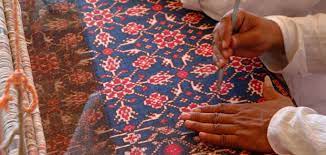
(image credit:- outlook India)
Themes & Patterns of Ikkat Saree
The word ikkat derives from a Malaysian word known as mengikat which means to tie or fold over. The Ikat design pattern involves the binding of the threads of the yarn into desired designs before the fabric online is dyed and subsequently woven.
Today you can find Ikkat weaving in not only sarees but in various other clothing like Ikkat dress materials for suits. You can even find Ikkat home furnishing because of the popularity of the craft among people.
The following themes and patterns are usually seen in ikat design patterns:
-
Traditional Motifs
Ikat sarees usually have traditional patterns that are usually inspired by religious places, such as conch shells, peacocks, lotus flowers, etc.
-
Geometric Patterns
Ikat design can be used to create geometric patterns such as stripes, squares, etc. The Raw Silk Pochampally Double Ikat Pure Handwoven Fabric on iTokri is an excellent example of this particular pattern.
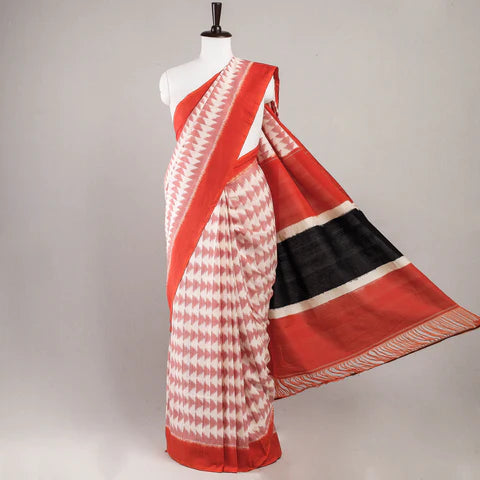
-
Floral Patterns
Some of the ikat silk sarees also feature beautiful floral patterns. These designs can be made in a range of different colours.
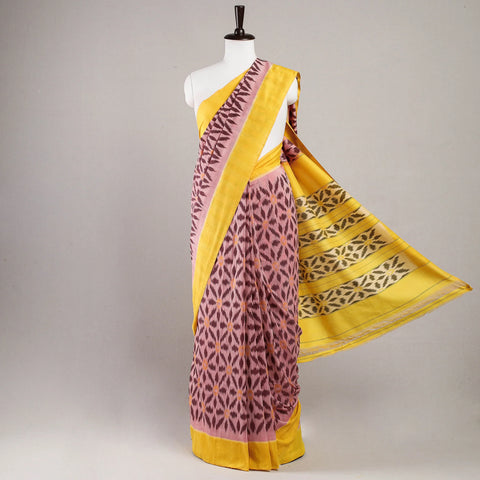
-
Contrast Borders
The Handspun Pochampally Ikat Silk Dupatta with Zari Border is an ideal representation of the manner in which contrast borders can heighten the visual appeal of this garment.
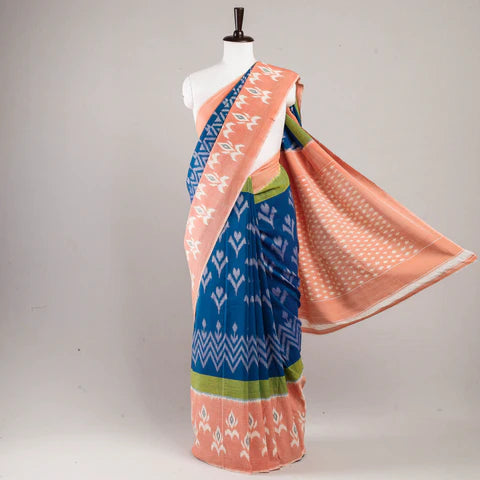
-
Abstract Patterns
The Ikat weaving technique makes it possible for the partisan to weave different designs that truly make the saree unique.
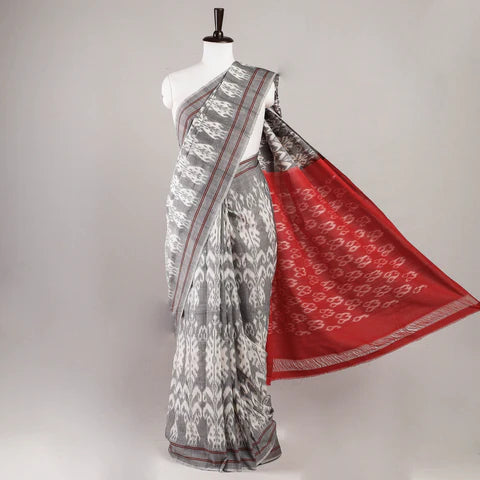
Styling Tips For Ikkat Odisha Saree For Any Occasion
While we have been discussing the Ikat sarees of Odisha for the longest time, the only proposition still left for discussion is how to style Odisha's famous saree. Being a fusion of contemporary aesthetics and traditional prints or styles, Ikkat has secured the perfect sweet spot between these two. So draping it around is safe for almost every event, be it formal or informal.
So let’s find out how you can dress up or down Ikat sarees of Orissa for office events, casual days out and semi-formal occasions such as anniversaries or marriage:
Office Attire
You will surely garner compliments from your colleagues or event participants when you cloak the 6-yard wonder - handwoven Ikkat silk saree - in light-toned, muted hues with no-makeup makeup look, minimal jewellery, flats or kitten heels and a handbag.
Casual Wear
If you have a last-minute plan with friends or fiance, ditch everything else and take your casual look up a notch by draping Odisha's famous saree, Ikat with smokey-eye makeup look, junk jewellery, sling bags, and flats or wedges. You will turn heads if the saree is in colours such as black, pink, purple or heather.
Semi-Formal
The Ikat saree looks mesmerising during events such as festivals or weddings. When everyone around you dolls up in the most extravagant ensemble, you can turn yourself into the epitome of elegance and sophistication by simply choosing an Ikat saree in bright red or magenta, donning shimmery, party, glam makeup look, chic jewellery and matching shoes.
You only need to pay attention to the upkeep of your Ikat saree collection and you can rock them for years
Care for Ikkat Saree
Ikat sarees are very delicate, and they require categorical care to maintain their optimum texture and shine. The following steps can be adhered to effectively care for your ikat silk sarees:
-
Avoid Spraying Perfume Directly Onto Them
Do not spray perfume or any body mist directly onto the saree when you step out in it. This can damage the fabric and tarnish the texture of your saree.
-
Avoid Direct Sunlight
Always store the state in a cool and dry place. If your ikat silk saree is exposed to sunlight can cause discolouration of the fabric.
-
Appropriate Storage
Always neatly fold the saree and put it in a cotton or muslin cloth to keep it safe from any insects. You can also put some camphor or neem leaves near the saree to protect it from infestation.
-
Dry Cleaning
Silk sarees with the ikat design pattern are usually very delicate, and therefore you should opt for professional cleaning (dry cleaning) to ensure proper cleaning and care of the saree.
Conclusion
Ikat silk sarees are nothing less than treasures in a woman’s wardrobe. These traditional Indian sarees epitomize our rich cultural heritage and history. The sheer effort and attention to detail that goes into making these sarees are impeccable. By taking note of the aforementioned care tips, you can ensure that the beauty of your saree is adequately preserved. This will also enable you to pass on these sarees as an heirloom to your loved ones.
FAQs
-
Which silk saree is famous in Odisha?
The Sambalpuri saree which is a hand-woven ikat silk saree is the most famous silk sarees in Odisha. In addition to that, the Berhampuri Patta Silk hand-woven sarees, Pasapali, Khandua, Kataki and Manibandhi are also famous in this region. -
Which Ikat is identified with the Odisha handloom?
The Odisha ikat which is a resist dyeing technique of yarn before weaving it into a fabric is known as the ‘Bandha Of Orissa’. This technique has had the geographical tag of the state since 2007.
-
Is Ikkat silk saree expensive?
An Ikat silk saree entails intricate design patterns that require a labour-intensive process. Depending upon the complexity of the design, the price of the saree is decided.
-
Which state is famous for Ikkat saree?
Odisha Ikat which is also known as Bandha or Bandhkala is a highly sought-after form of Ikat that is used on sarees and other dress materials. Furthermore, Telangana is also famous for its Pochampally Ikat; widely known as Chitki.
-
When and where is the origin of Ikkat silk?
The oldest known account of Ikkat Silk saree origin finds its mention almost 5000 years ago when an Indian Odishan style of Ikat art was seen in a pharaoh's tomb. It also alludes to a blooming textile trade relationship between India and Egypt in ancient times.
-
Are there any other garments in ikkat silk other than sarees?
Yes. The Ikat design pattern can be found on dupattas, dresses, and dress material. In addition to that, home decor items and various other products can also be made using this technique.
-
What is the Speciality of Ikat saree?
A special characteristic of Ikat sarees is that it has a unique blurry design which is a result of the cumbersome process that the weaver undertakes for lining up dyed yarns.
 Verified Purchase
Verified Purchase
































































Leave a comment (all fields required)